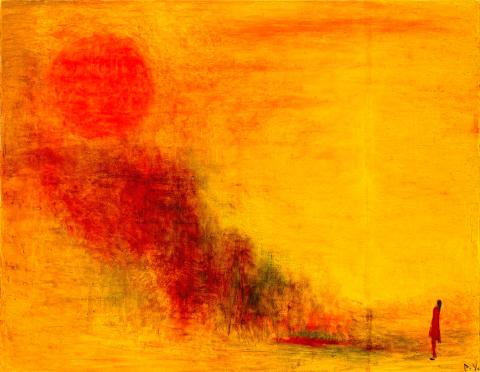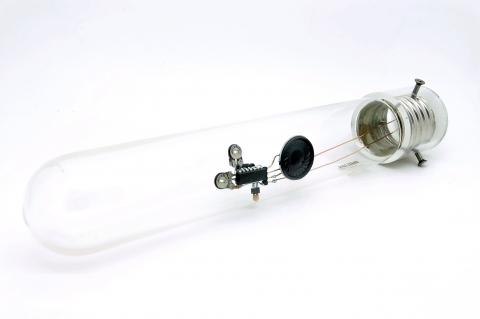Flawless (無缺) is a solo exhibition of wood sculptures by Miaoli County native Chiu Shih-fu (邱仕福). Chiu learned to chisel at age 13 as a child laborer and has worked in the industry for 47 years. He specializes in figures of humans and animals, styled in lyrical lines that echo western Romanticism. They typically appear in pairs so as to keep each other company, according to the gallery notes.
■ Sanyi Wood Sculpture Museum (三義木雕博物館), 88 Kuangsheng Hsincheng, Kuangsheng Village, Sanyi Township, Miaoli County (苗栗縣三義鄉廣盛村廣聲新城88號), tel: (037) 876-009. Open Mondays to Saturdays from 9am to 5pm. Admission: NT$80, NT$50 for Miaoli residents
■ Until Nov. 30

Photo Courtesy of Metaphysical Art Gallery
Sound State (聲態) collects new experiments by sound art pioneer Wang Fu-jui (王福瑞). Five pieces explore the possibilities of sound: One converts audio vibrations to visuals on a TV set, while another uses false computing protocols to generate true random noise that is emancipated from the machine. Wang is head of the Trans-Sonic Lab of the Taipei National University of the Arts and founder of Noise, the first noise/experimental music label in Taiwan.
■ Digital Art Center (台北數位藝術中心), 180 Fuhua Rd, Taipei City (台北市福華路180號), tel: (02) 7736-0708. Open Tuesdays to Sundays from 10am to 6pm, except Nov. 28 and Nov. 29. Free admission
■ Until Dec. 28

Photo Courtesy of DAC, Taipei
The Sun Never Sets (日不落) is a career retrospective for acclaimed oil painter Wang Pan-youn (王攀元). Born in 1911 in Jiangsu (江蘇), the artist immigrated in 1949 to Yilan County, where he still lives today. Wang’s war-shaped life story has appeared in his work as an inflammatory color palette and the use of negative space to create an aura of isolation.
■ Metaphysical Art Gallery (形而上畫廊), 7F, 219, Dunhua S Rd Sec 1, Taipei City (台北市敦化南路一段219號7樓), tel: (02) 2771-3236. Open Tuesdays to Sundays from 11am to 6:30pm, closed on Mondays
■ Opens tomorrow. Until Dec. 20
Coordinated with Switzerland’s Kindermuseum Creaviva at the Zentrum Paul Klee, Get Rhythm with Paul Klee is an interactive exhibit and workshop series for children aged 4 to 15. The program introduces youth to Swiss-German artist Paul Klee via game stations, painting studios and dance workshops led by the Cloud Gate Dance School. Klee is known for his striking use of color, lines, symbols and musical themes on the canvas, which help make his catalog accessible to children. To register for activities, visit www.tfam.museum/kid.
■ Children’s Art Education Center at the Taipei Fine Arts Museum, 181, Zhongshan N Rd Sec 3, Taipei (台北市中山北路三段181號), tel: (02) 2595-7656. Open Tuesdays to Sundays from 9:30am to 5:30pm and until 8:30pm on Saturdays. Admission: NT$30
■ Opens tomorrow. Until April 12
Greater Kaohsiung native Huang Hua-chen (黃華真) presents From Now On (全新的你), a mixed media solo exhibition inspired by the artist’s study abroad trip to Finland last year. In new paintings, installations and video work, Huang depicts seemingly sentient plants and gem-like carved rocks that exude warmth.
■ VT Art Salon (非常廟藝文空間), B1, 47 Yitong St, Taipei City (台北市伊通街47號B1), tel: (02) 2516-1060. Open Tuesdays through Thursdays from 1:30pm to 9pm, and Fridays and Saturdays from 1:30pm to 10pm
■ Until Dec. 6
My New Eros (我的新愛神EROS!) is a group show of photos themed on love (戀愛) or sexuality (性感). Contributors include professional photographer Jimmy Ming Shum (沈平林) from Hong Kong, as well as amateur shutterbugs such as talk-show host Huang Tzu-chiao (黃子佼). All proceeds from sales go to charity.
■ Little MOCA (微當代文創), 17, Ln 17, Chengde Rd Sec 1, Taipei City (臺北市承德路一段41巷17號), tel: (02) 2558-1787 Open Tuesdays to Sundays from 11am to 6pm
■ Until Dec. 27

President William Lai (賴清德) has championed Taiwan as an “AI Island” — an artificial intelligence (AI) hub powering the global tech economy. But without major shifts in talent, funding and strategic direction, this vision risks becoming a static fortress: indispensable, yet immobile and vulnerable. It’s time to reframe Taiwan’s ambition. Time to move from a resource-rich AI island to an AI Armada. Why change metaphors? Because choosing the right metaphor shapes both understanding and strategy. The “AI Island” frames our national ambition as a static fortress that, while valuable, is still vulnerable and reactive. Shifting our metaphor to an “AI Armada”

When Taiwan was battered by storms this summer, the only crumb of comfort I could take was knowing that some advice I’d drafted several weeks earlier had been correct. Regarding the Southern Cross-Island Highway (南橫公路), a spectacular high-elevation route connecting Taiwan’s southwest with the country’s southeast, I’d written: “The precarious existence of this road cannot be overstated; those hoping to drive or ride all the way across should have a backup plan.” As this article was going to press, the middle section of the highway, between Meishankou (梅山口) in Kaohsiung and Siangyang (向陽) in Taitung County, was still closed to outsiders

The older you get, and the more obsessed with your health, the more it feels as if life comes down to numbers: how many more years you can expect; your lean body mass; your percentage of visceral fat; how dense your bones are; how many kilos you can squat; how long you can deadhang; how often you still do it; your levels of LDL and HDL cholesterol; your resting heart rate; your overnight blood oxygen level; how quickly you can run; how many steps you do in a day; how many hours you sleep; how fast you are shrinking; how

US President Donald Trump may have hoped for an impromptu talk with his old friend Kim Jong-un during a recent trip to Asia, but analysts say the increasingly emboldened North Korean despot had few good reasons to join the photo-op. Trump sent repeated overtures to Kim during his barnstorming tour of Asia, saying he was “100 percent” open to a meeting and even bucking decades of US policy by conceding that North Korea was “sort of a nuclear power.” But Pyongyang kept mum on the invitation, instead firing off missiles and sending its foreign minister to Russia and Belarus, with whom it